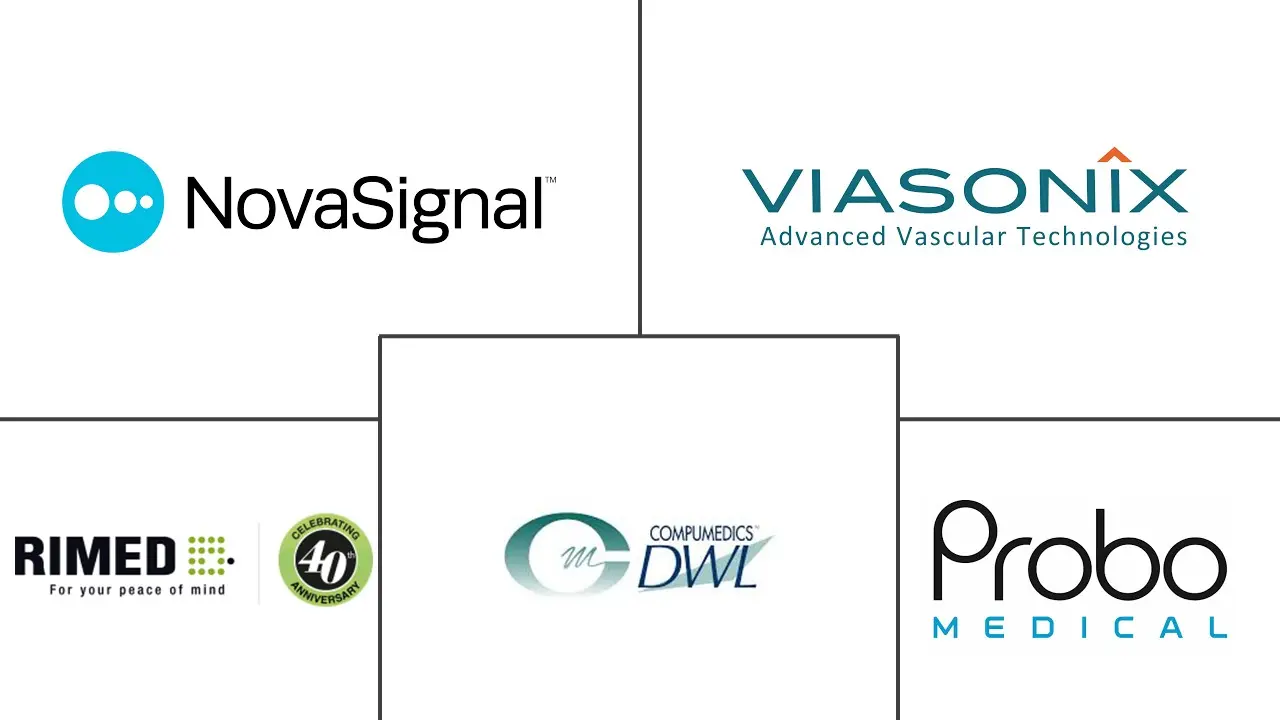Transcranial Doppler Ultrasound Market Size and Share
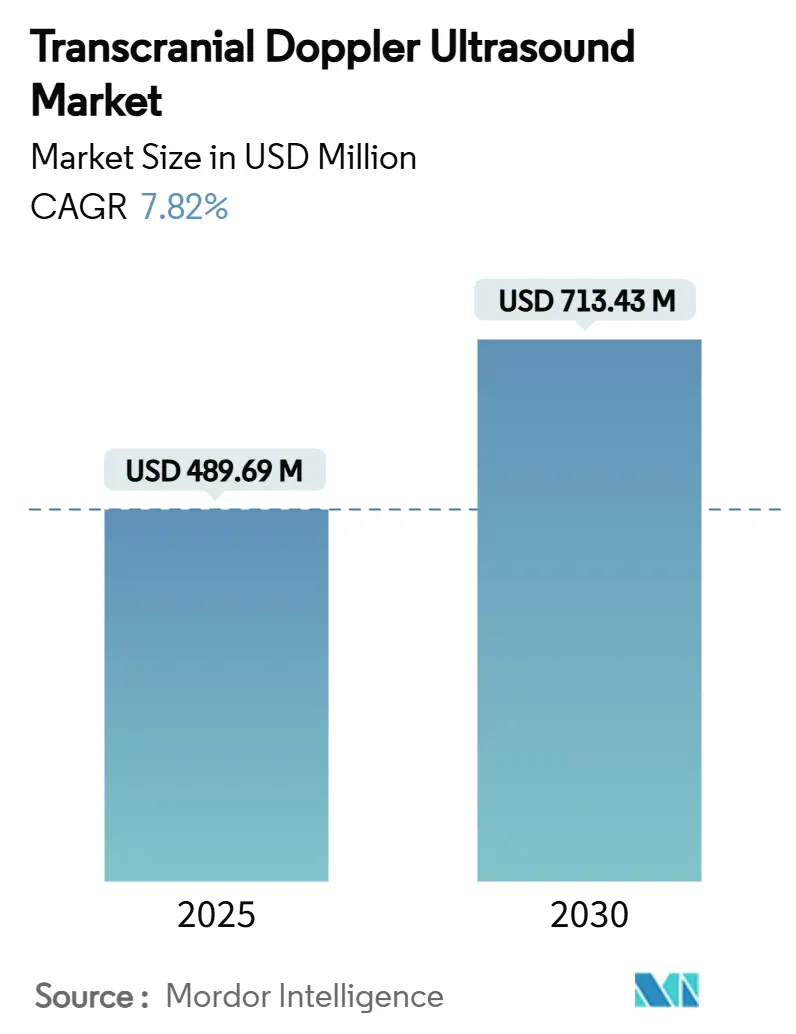
Transcranial Doppler Ultrasound Market Analysis by Mordor Intelligence
The Transcranial Doppler Ultrasound Market size is estimated at USD 489.69 million in 2025, and is expected to reach USD 713.43 million by 2030, at a CAGR of 7.82% during the forecast period (2025-2030).
Rapid clinical uptake of non-invasive cerebrovascular monitoring, expanding stroke center networks, and AI-enabled diagnostic enhancements are the core growth catalysts. Portable and robotic devices are broadening access beyond tertiary hospitals, while reimbursement reforms in key countries are gradually easing capital constraints. Intensifying competition around automation, probe miniaturization, and cloud-based analytics is redefining value propositions. Meanwhile, persistent operator dependency and heterogeneous payment policies temper the pace of standardized roll-outs, especially in resource-constrained settings.
Key Report Takeaways
- By application, acute ischemic stroke held 34.62% of transcranial doppler ultrasound market share in 2024; traumatic brain injury monitoring is advancing at an 8.96% CAGR to 2030.
- By device type, stand-alone systems captured 62.48% revenue share in 2024, while portable units are expanding at a 10.82% CAGR through 2030.
- By end user, hospitals accounted for 69.13% of the transcranial doppler ultrasound market size in 2024 and ambulatory surgical centers are growing at 9.16% CAGR between 2025-2030.
- By geography, North America commanded 41.71% of the 2024 transcranial doppler ultrasound market share; Asia-Pacific is set to grow at 8.28% CAGR to 2030.
Global Transcranial Doppler Ultrasound Market Trends and Insights
Drivers Impact Analysis
| Market Driver | (~) % Impact on CAGR Forecast | Geographic Relevance | Impact Timeline |
|---|---|---|---|
| Rising global stroke incidence & aging demographics | +2.1% | North America, Europe, East Asia | Medium term (2–4 years) |
| Proliferation of comprehensive stroke centers & tele-stroke networks | +1.8% | North America, Europe, urban Asia-Pacific | Short term (≤ 2 years) |
| Expansion of point-of-care ultrasound programs | +1.4% | Global, early adoption in developed markets | Medium term (2–4 years) |
| Technological convergence improving diagnostic yield & accessibility | +1.9% | North America, Europe | Medium term (2–4 years) |
| Rising emphasis on preventive neurological screening | +1.3% | Europe, East Asia | Long term (≥ 4 years) |
| Adoption of portable & AI-integrated TCD systems | +1.5% | Global | Short term (≤ 2 years) |
| Source: Mordor Intelligence | |||
Rising Global Stroke Incidence & Aging Demographics Elevating Demand for Rapid Neuro-vascular Screening
The worldwide rise in ischemic stroke cases, now surpassing 11.9 million annually, is intensifying demand for fast, bedside cerebrovascular assessments.[1]The Global Burden of Stroke Collaborators, “Global, regional, and national burden of stroke, 1990-2024,” The Lancet, thelancet.com Aging populations in Europe, Japan, and the United States magnify this trend as hypertension and obesity prevalence remain high. Governments and health systems are prioritizing early-stage detection, placing Transcranial Doppler Ultrasound market solutions at the center of stroke prevention pathways. Large data sets linking middle cerebral artery flow patterns to functional outcomes strengthen clinical confidence and reimbursement prospects. Consequently, procurement budgets for portable neuro-vascular scanners are rising in neurology, cardiology, and emergency departments.
Proliferation of Comprehensive Stroke Centers & Tele-stroke Networks Enhancing TCD Utilization
National stroke strategies are accelerating licensure of advanced thrombectomy hubs, each requiring around-the-clock neuro-diagnostics. In France, mechanical thrombectomy capacity remains at 7,500 procedures versus a 20,500-case potential, driving hospitals to integrate automated Transcranial Doppler Ultrasound market platforms for collateral-flow triage. Tele-stroke networks further leverage real-time Doppler waveforms to guide patient transfer decisions. These service expansions shorten door-to-reperfusion intervals and underscore the modality’s critical role, directly lifting device sales and service contracts.
Expansion of Point-of-Care Ultrasound Programs Boosting Neuro-sonology Training & Adoption
Sixty-three percent of pediatric neurocritical-care centers now apply bedside Doppler exams; 74% modify care plans instantly based on results.[2]Laura B. Maitland et al., “Point-of-Care Transcranial Doppler in Pediatric Neurocritical Care,” Journals.LWW.com Residency curricula increasingly incorporate neuro-sonology modules, reducing the skills gap that historically limited penetration. The Lucid Robotic System secures reliable windows in 56 seconds, allowing nurses to initiate monitoring during stabilization. Such productivity gains make the Transcranial Doppler Ultrasound market viable for intensive-care units and ambulance services, spurring recurrent demand for disposable probes and cloud analytics.
Technological Convergence Improving Diagnostic Yield & Accessibility
AI-driven flow-pattern classifiers now flag large-vessel occlusion with 93% sensitivity, while 3D ultrasound localization microscopy maps vessels as small as 60 μm through an intact skull.[3]Jingwei Fan et al., “Three-Dimensional Ultrasound Localization Microscopy of Cerebral Microvasculature,” arxiv.org Wearable patches developed at UC San Diego capture thousands of images each second, supporting continuous cerebral autoregulation tracking. Combined, these breakthroughs diminish operator variability and unlock new chronic-care applications such as non-invasive intracranial pressure estimation. Investors consequently channel capital into start-ups focused on portable Transcranial Doppler Ultrasound market endpoints for home-based stroke surveillance.
Restraints Impact Analysis
| Market Restraint | (~) % Impact on CAGR Forecast | Geographic Relevance | Impact Timeline |
|---|---|---|---|
| High operator dependency & learning curve | -1.6% | Global, acute in emerging markets | Short term (≤ 2 years) |
| Reimbursement variability across regions | -1.2% | North America, Europe | Medium term (2–4 years) |
| Increasing availability & cost decline of alternative neuro-imaging modalities | -1.3% | Global | Long term (≥ 4 years) |
| Lack of standardized protocols across clinical settings | -1.1% | Global | Medium term (2–4 years) |
| Source: Mordor Intelligence | |||
High Operator Dependency and Learning Curve Limiting Standardized Interpretations Across Sites
Traditional systems require expert sonographers to identify acoustic windows; waveform variability of 40% day-to-day in severe TBI illustrates the challenge. Differing pressure-flow relationship categories complicate treatment algorithms. These technical hurdles deter smaller hospitals from purchasing systems and restrain broad reimbursement approvals. Robotics and AI partially offset the problem but do not fully eliminate the need for structured credentialing.
Reimbursement Variability Across Regions Constraining Capital Procurement Budgets
Medicare in the United States reimburses transcranial doppler ultrasound market exams only for narrowly defined indications such as sickle-cell screening or collateral-flow checks during carotid surgery. Coupled with a 4.6% decline in inflation-adjusted neurosurgical payments, administrators hesitate to allocate funds for new consoles. Divergent coding frameworks in Europe create similar uncertainty, leading to regional adoption gaps despite clinical consensus on utility.
Segment Analysis
By Application: Stroke Care Leads While TBI Gains Traction
Acute ischemic stroke accounted for the largest transcranial doppler ultrasound market share at 34.62% in 2024, supported by guideline endorsements for collateral-flow mapping prior to mechanical reperfusion. Integration into multimodal stroke pathways sustains equipment refresh cycles across comprehensive centers. Traumatic brain injury monitoring is the fastest climber with an 8.96% CAGR, propelled by defense-sector research and sports-medicine protocols. Pediatric sickle-cell screening remains a stable revenue stream anchored by mandatory annual protocols, while cerebral vasospasm surveillance after subarachnoid hemorrhage holds steady due to strong evidence backing daily Doppler checks.
Continuous innovation overlays all applications. AI-augmented decision support now suggests shunt gradings within seconds, narrowing interpretation variance. Cloud-based reporting accelerates neurosurgeon consults, allowing rapid escalation to angiography when flow velocities exceed critical thresholds. Collectively, these advances deepen clinical reliance on transcranial doppler ultrasound market solutions and extend monitoring beyond acute episodes into secondary-prevention regimes.
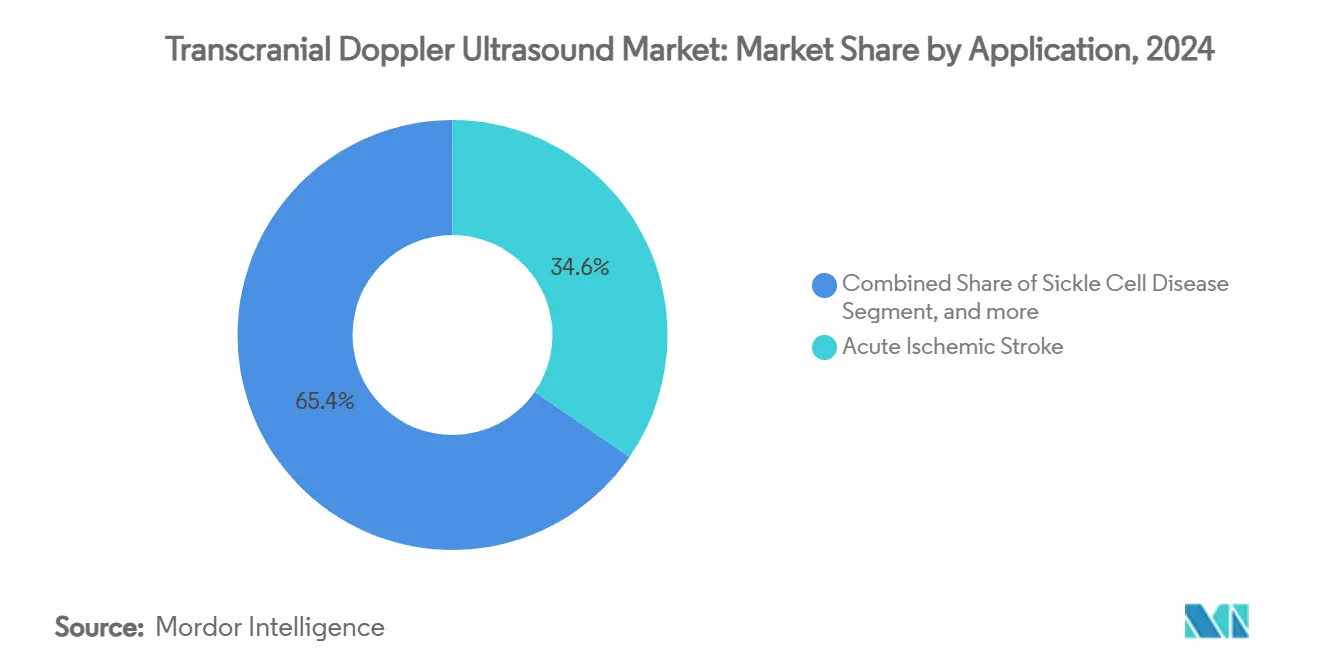
Note: Segment shares of all individual segments available upon report purchase
By Device Type: Portable Systems Alter Point-of-Care Landscape
Stand-alone consoles retained 62.48% revenue in 2024, underpinned by sophisticated waveform analytics and integrated patient-record interfaces in tertiary hospitals. However, portable units are registering a 10.82% CAGR, reflecting clinician preference for rapid bedside deployment. The transcranial doppler ultrasound market size attached to handheld devices is projected to double by 2030, driven by ambulance pilots and rural stroke-network roll-outs. Wearable patches now provide continuous bilateral flow trending, bridging gaps between periodic examinations.
Manufacturers enhance stand-alone offerings with robotic probe arms and AI libraries, preserving relevance for high-complexity cases. Hybrid carts embed battery-powered Doppler transceivers that dock into larger workstations, blurring category lines. A growing refurbished-equipment channel in Southeast Asia and Latin America further broadens access, although it exerts downward pressure on average selling prices.
By End User: Hospital Dominance Persists Amid Outpatient Surge
Hospitals controlled 69.13% of expenditure in 2024 as stroke teams expand neuro-vascular imaging arsenals. High-acuity needs keep demand resilient even as payers push procedures to lower-cost sites. The transcranial doppler ultrasound market share in ambulatory surgical centers is set to climb, supported by portable device economics aligning with short-stay reimbursement models. Diagnostic laboratories leverage cloud-linked Doppler fleets for routine sickle-cell screenings, while academic institutes drive prototype evaluations, securing grants for algorithm training on large flow-velocity datasets.
Industry partnerships between device OEMs and university hospitals facilitate validation of novel indices such as pulsatile cranial-expansion correlations with intracranial pressure. These collaborations seed future chronic-care applications and reinforce the Transcranial Doppler Ultrasound industry innovation pipeline.
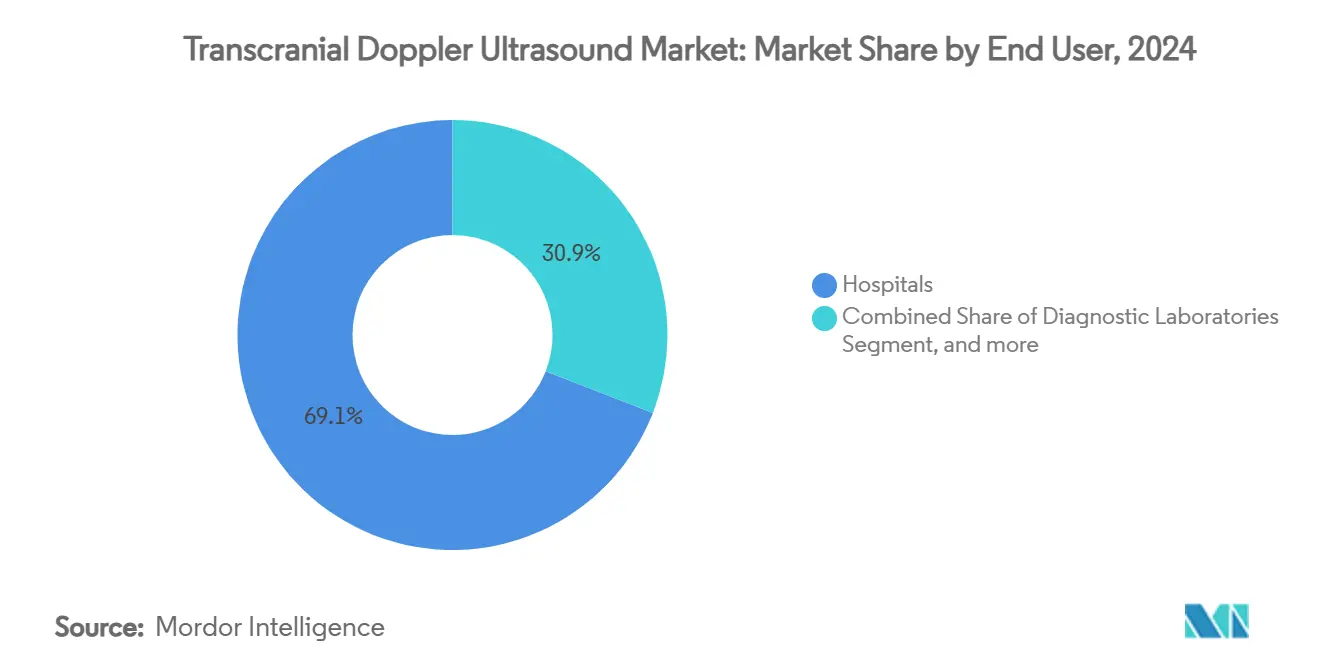
Note: Segment shares of all individual segments available upon report purchase
Geography Analysis
North America led with 41.71% revenue in 2024, anchored by dense stroke-center networks and structured neuro-critical-care pathways. Favorable CPT codes for sickle-cell and carotid assessments support baseline volumes, though wider indication gaps remain. Pilot programs equipping paramedic teams with lightweight scanners illustrate the region’s appetite for pre-hospital adoption.
Europe ranks second, benefiting from universal coverage and robust research funding. France’s under-utilization of thrombectomy underscores latent demand for diagnostic capacity expansion; the United Kingdom’s GBP 6.5 (USD 8.7) million ultrasound brain-computer interface trial underscores public-sector commitment to frontier neuro-technologies. Meanwhile, Germany and the Nordics pursue national registry initiatives that integrate Doppler metrics, fostering evidence-based reimbursement dialogues.
Asia-Pacific is the fastest-growing territory at 8.28% CAGR as stroke incidence rises sharply and governments invest in tele-medicine. China’s provincial stroke-care maps mandate Doppler access in secondary hospitals, while India’s new stroke units boost procurement of portable consoles suitable for district facilities. Japan advances preventive screening programs targeting silent cerebral infarcts in seniors, amplifying recurring probe and maintenance revenues. Smaller but strategically important markets in the Middle East & Africa and South America embrace public-private financing models to import Transcranial Doppler Ultrasound market technologies alongside broader critical-care upgrades.
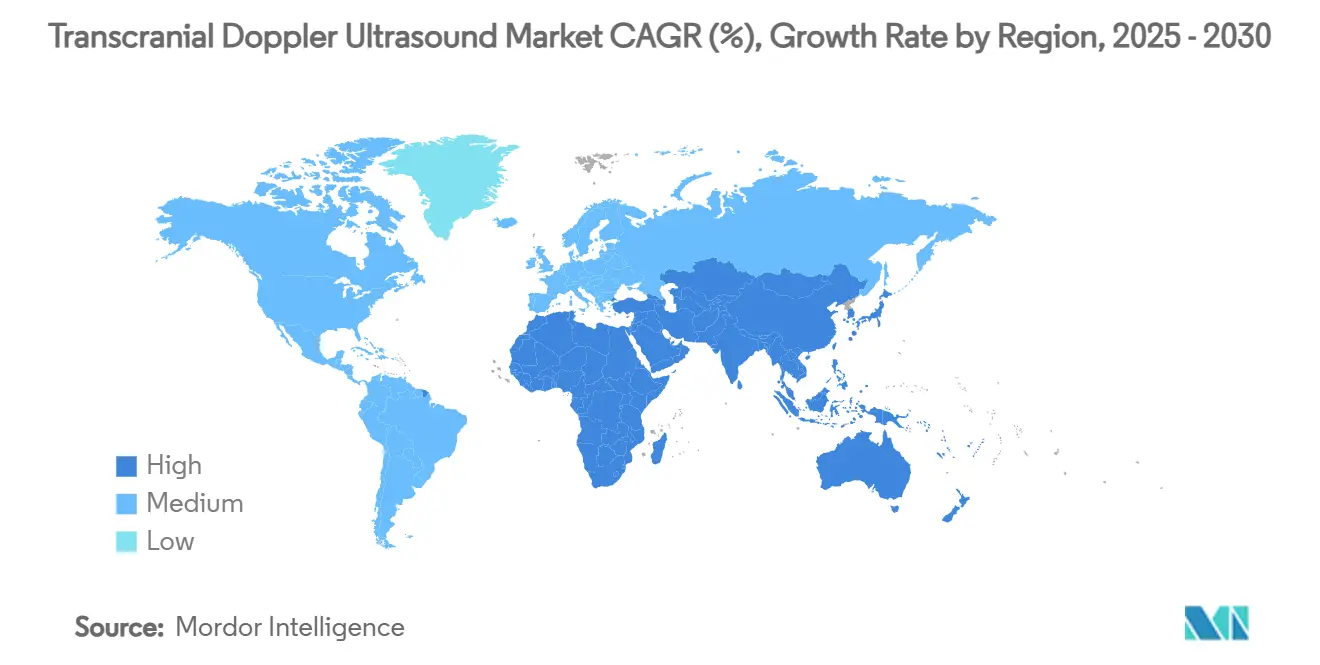
Competitive Landscape
The transcranial doppler ultrasound market is moderately concentated. NovaSignal, Viasonix, Rimed, and DWL Elektronische Systeme concentrate on neuro-sonology exclusives, differentiating through AI-embedded workflow automation. GE Healthcare, Koninklijke Philips N.V., Fujifilm Sonosite, and Samsung Medison leverage enterprise imaging ecosystems to bundle Doppler with cardiac and vascular ultrasound lines, capturing health-system-wide contracts.
Strategic collaborations accelerate feature roll-outs: Bracco Imaging’s alliance with BURL aims at ischemic stroke detection using advanced contrast agents. Patent activity around wearable transducers surged in 2024, highlighted by Novosound’s flexible-membrane sensor grant that paves the way for continuous monitoring bands. Robotics integration, epitomized by the Lucid System, eliminates expert sonographer dependency and signals a shift toward unattended monitoring stations in emergency rooms.
Pricing competition intensifies as Chinese entrants offer cost-effective portable units, prompting incumbents to emphasize software subscriptions and analytics dashboards. White-space opportunities persist in non-invasive intracranial pressure estimation, cerebral autoregulation trending, and home-based secondary stroke prevention kits areas where start-ups can carve niches before conglomerates replicate features.
Transcranial Doppler Ultrasound Industry Leaders
-
Viasonix
-
Rimed
-
B. Braun Melsungen AG
-
Konica Minolta Healthcare India Pvt. Ltd.
-
NovoSignal Corp
- *Disclaimer: Major Players sorted in no particular order
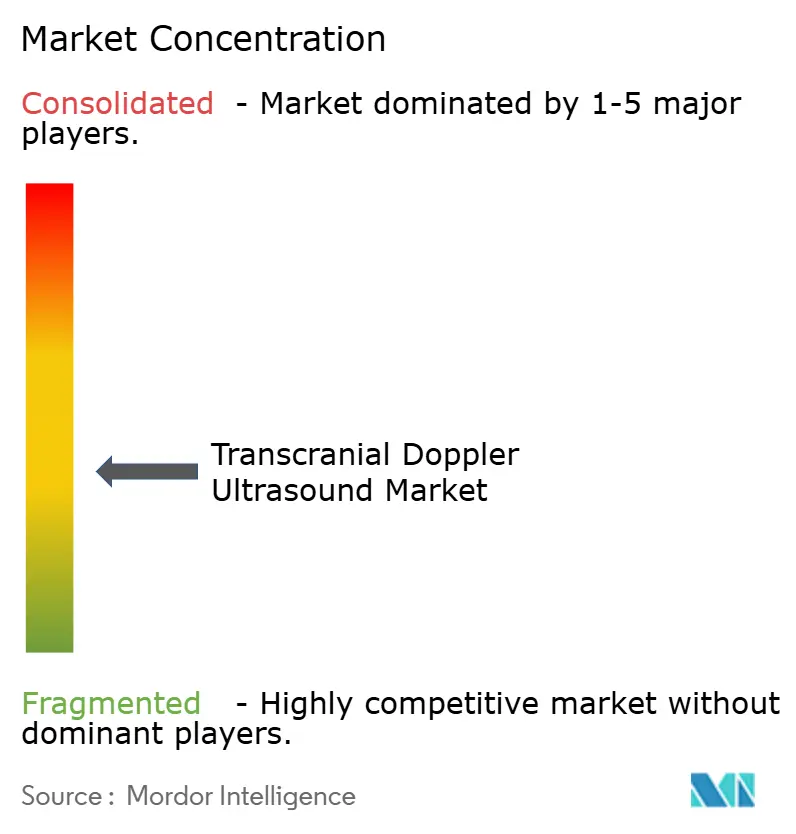


Recent Industry Developments
- March 2025: NeuraSignal, a global player in Transcranial Doppler (TCD) technology and the only licensed TCD manufacturer cleared by Health Canada, has solidified its position as an industry leader in neurovascular care. The company’s advanced TCD systems are setting new standards in accuracy, efficiency, and usability for detecting and managing neurological conditions such as Right-to-Left Shunt (RLS) / Patent Foramen Ovale (PFO), vasospasm, and cryptogenic stroke. With the latest release, healthcare providers across Canada now have access to cutting-edge robotic TCD technology that combines exceptional performance with intelligent automation.
- September 2024: A new publication from ERN-EuroBloodNet highlights the limited access to Transcranial Doppler (TCD) screening and stroke prevention for children with sickle cell disease (SCD) across Europe. As part of a European mapping exercise, ERN-EuroBloodNet aimed to assess the state of TCD screening and stroke prevention programs in European Expert Centers. The exercise also identified key challenges, including restricted access, insufficient staff training, and the lack of adequate protocols for implementing TCD and subsequent treatment. These issues are set to be addressed through targeted actions within the network to improve care for pediatric SCD patients.
- June 2024: MIT researchers developed an ultrasound-based method for deep brain stimulation, offering a safer alternative to traditional electrical stimulation used in treating Parkinson's disease through a hair-thin fiber that delivers ultrasound to stimulate neurons.
Global Transcranial Doppler Ultrasound Market Report Scope
As per the scope of the report, the transcranial doppler ultrasound system is the technology used for measuring the velocity of blood flow through the brain arteries by measuring the echoes of ultrasound waves. It provides real-time measures of cerebrovascular functions. The Transcranial Doppler Ultrasound Market is segmented by Application (Sickle Cell Disease, Acute Ischemic Stroke, and Intracranial Steno Occlusive disease), End User (Hospitals and Diagnostic Laboratories), and Geography (North America, Europe, Asia-Pacific, Middle-East and Africa, and South America). The market report also covers the estimated market sizes and trends for 17 different countries across major regions globally. The report offers the value (in USD million) for the above segments.
| Sickle Cell Disease |
| Acute Ischemic Stroke |
| Intracranial Steno-Occlusive Disease |
| Cerebral Vasospasm Monitoring |
| Traumatic Brain Injury Management |
| Stand-alone Systems |
| Portable/Hand-held Systems |
| Hospitals |
| Diagnostic Laboratories |
| Ambulatory Surgical Centers |
| Academic & Research Institutes |
| North America | United States |
| Canada | |
| Mexico | |
| Europe | Germany |
| United Kingdom | |
| France | |
| Italy | |
| Spain | |
| Rest of Europe | |
| Asia-Pacific | China |
| Japan | |
| India | |
| Australia | |
| South Korea | |
| Rest of Asia-Pacific | |
| Middle East & Africa | GCC |
| South Africa | |
| Rest of Middle East & Africa | |
| South America | Brazil |
| Argentina | |
| Rest of South America |
| By Application | Sickle Cell Disease | |
| Acute Ischemic Stroke | ||
| Intracranial Steno-Occlusive Disease | ||
| Cerebral Vasospasm Monitoring | ||
| Traumatic Brain Injury Management | ||
| By Device Type | Stand-alone Systems | |
| Portable/Hand-held Systems | ||
| By End User | Hospitals | |
| Diagnostic Laboratories | ||
| Ambulatory Surgical Centers | ||
| Academic & Research Institutes | ||
| By Geography | North America | United States |
| Canada | ||
| Mexico | ||
| Europe | Germany | |
| United Kingdom | ||
| France | ||
| Italy | ||
| Spain | ||
| Rest of Europe | ||
| Asia-Pacific | China | |
| Japan | ||
| India | ||
| Australia | ||
| South Korea | ||
| Rest of Asia-Pacific | ||
| Middle East & Africa | GCC | |
| South Africa | ||
| Rest of Middle East & Africa | ||
| South America | Brazil | |
| Argentina | ||
| Rest of South America | ||


Key Questions Answered in the Report
What is the current transcranial doppler ultrasound market size?
The transcranial doppler ultrasound market size is USD 489.69 million in 2025.
How fast will the transcranial doppler ultrasound market grow?
The market is forecast to register a 7.82% CAGR between 2025 and 2030.
Which application segment leads the transcranial doppler ultrasound market?
Acute ischemic stroke leads with 34.62% market share as of 2024.
Why are portable systems gaining traction in the transcranial doppler ultrasound market?
Portable units offer point-of-care flexibility and are growing at a 10.82% CAGR, driven by stroke-network deployments and ambulance integration.
Which region is the fastest-growing for transcranial doppler ultrasound solutions?
Asia-Pacific leads growth with an 8.28% CAGR, supported by expanding stroke centers and healthcare investment.
Page last updated on:
